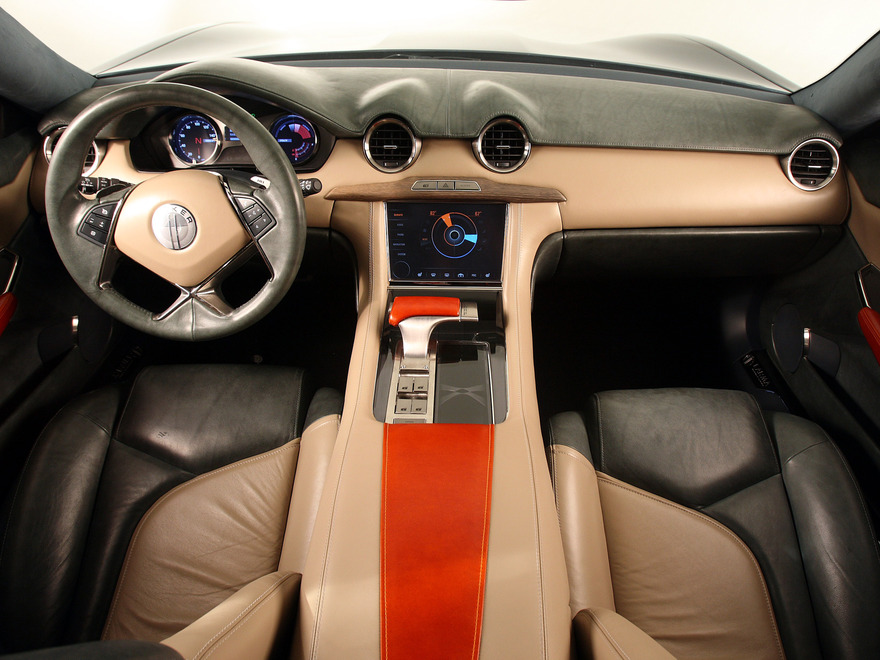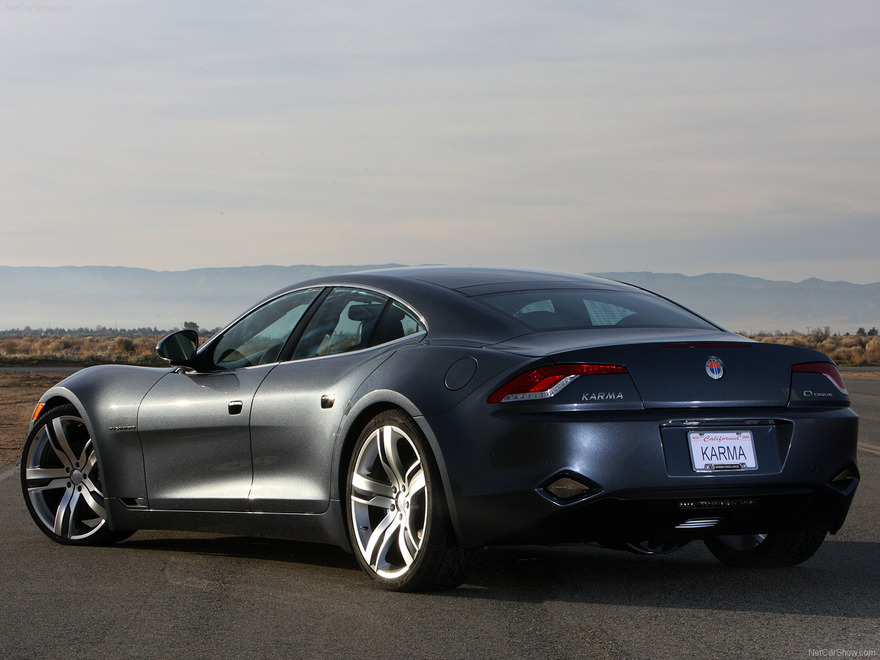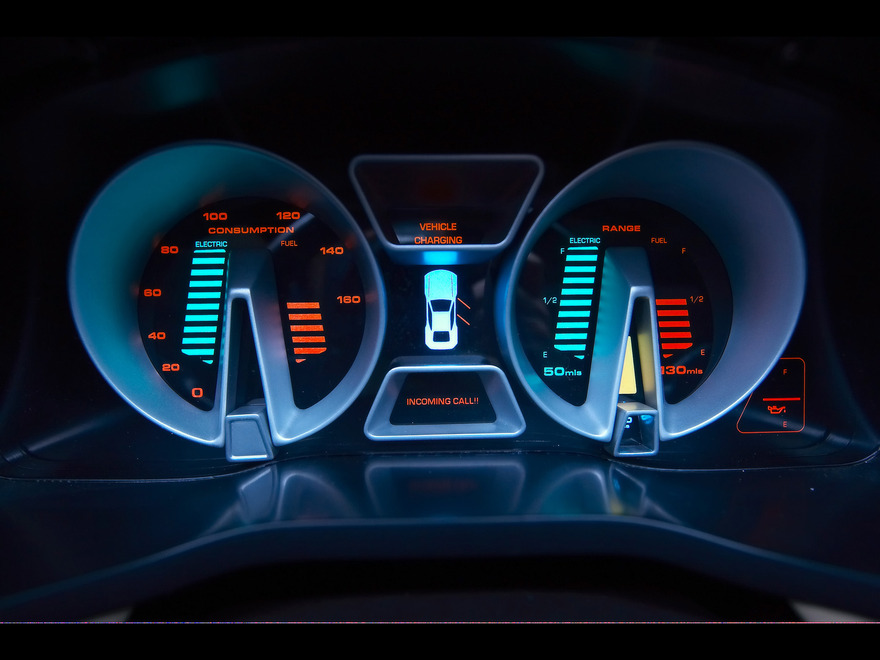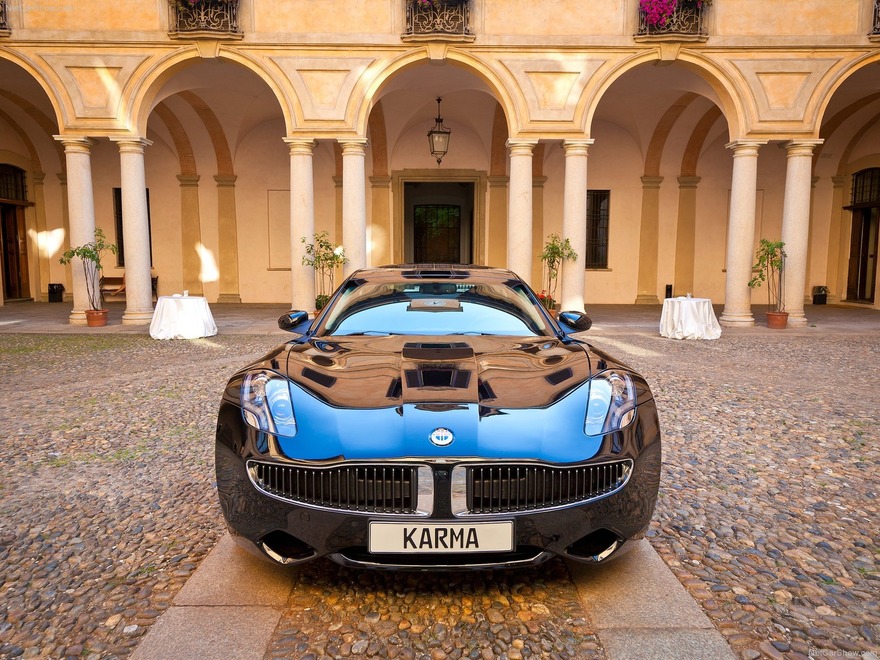It’s quite and comfortable in the city, fast on highways — both environmental activists and aesthetes like the 2011–2012 hybrid car Fisker Karma.
The controllable and nimble 4-door luxury sports sedan is rather impressive in size — almost 5 metres long, wheelbase like the one from an S-class, wider than Porsche Panamera. Your sight is arrested by huge wheels, solar panel on the roof and bright Diamond Dust coating (paint with glass particles received from recycled bottles for more glitter). It takes the whole day for the solar panel placed on the roof to produce energy enough to cover 1 kilometre distance and that is why it only powers the climate control system and is meant to offload the hybrid system.
The car’s exterior is imperial — it was designed by Henrik Fisker who was previously working on the design of BMW Z8 and Aston Martin DB9. The supercar’s interior is finished with high-quality leather and wood. A big touchscreen is installed on the dashboard.
The model is suggested in three trim levels — EcoBase, EcoSport and EcoChic. Technically they are almost the same; the only difference is in the level of luxury of the interior. The EcoChic version is the most expensive — they used natural Bamboo Viscose fabrics with an animal-free approach.
Fisker Karma is an electric car with an auxiliary engine. Two-litre 16-valve 4-cylinder direct-injection turbocharged engine fitted with an intercooler is installed in the vehicle’s front part. This motor (with 260 hp capacity) turns on only for producing electricity for powering a generator which is connected to it. A lithium ion battery is situated in the central tunnel of the car down to earth of the chassis in the middle of the wheelbase. It helps reaching an ideal axle weight distribution increasing the traction, stability and steering of the hybrid car. The manufacturers promise that the battery should have a life of 10 years 160,000 km under normal use. The two electric motors drive the rear wheels producing together 403 hp. The vehicle weighs more than 2 tons.
Instead of a regular gearbox the car is fitted with a gear selector which is shaped like a small pyramid with buttons: D, R, N. Two steering-wheel paddles control all the electronics — the right one brings the electric motors into the engine braking mode; the left paddle switches between Stealth and Sport acceleration modes.
When in Stealth mode, Fisker Karma supercar accelerates silently up to 100 km/h in 7.9 seconds, its top speed is 153 km/h. Instead of the exhaust pipes the car is fitted with diamond shaped speakers which produce sound for alerting pedestrians when the electric car is approaching them. It’s both an ecologic and economic mode. Powered only by electric traction, a fully charged Fisker Karma can cover the distance of almost 80 km without using the petrol engine, making it absolutely harmless for the environment. It can be charged through traditional home outlets. With the help of combustion engine, which charges the batteries, a fully fuelled car can cover the distance of 1000 km.
In Sport mode the turbos come to help the electronics. In this mode the powerplant is producing the torque of 1300 Nm which allows the car accelerating from 0 to 100 km/h in 6.3 seconds and reaching 200 km/h top speed. The sound of speakers is replaced by the roar of the real exhaust pipe coming out behind the front wheel. Fuel consumption is 2.4 litres per 100 km. Total distance in this mode is about 500 km.
According to the topgearrussia.ru website the performance level of Fisker in Sport mode does not reach that of a supercar: “Unfortunately, it only roars louder when burning the fuel. Considering the turbos only as a crutch for the discharged battery straightens it all out — Karma is impressively convincing as an electric car”.
But the price is a bit worrying — one will have to plank out €130,000 or more for Fisker Karma which is not that fast in sports mode. Although it might be worth of such price, as it is a beautiful, luxurious and silent city car.
A few facts:
1. Fisker Karma electric car is produced in the USA by Fisker Automotive company and manufactured at Valmet Automotive in Finland. The technical part of the Fisker Karma project was developed by Quantum Technologies located in California. It supplied Fisker Coachbuild with the innovative Q-Drive hybrid drive train. It comprises GM Ecotec petrol engine which is installed to charge the batteries.
2. Fisker Karma hybrid is directly competing with a fully electric car Tesla Roadster — they have almost equal price and the same customer range. The companies started an unspoken war for customers a long time ago — Tesla Motors was accusing Fisker Coachbuild of illegal use of some of design solutions developed by Henrik Fisker at the time he had worked at designing the electric innovation Tesla Model S. On 4 November 2008 the court made an interlocutory decision in favour of Fisker Automotive and ordered Tesla company to pay US$1,144,285 in costs.
3. After the destructive hurricane Sandy, which ravaged the Northeast coast of the USA at the end of October 2012, Fisker car manufacturer started experiencing serious financial problems. As a result they had to stop production of the new electric vehicles for several months which led to a wave of dismissals ending with the resignation of the company’s founder Henrik Fisker in March 2013. The company owes $168 million to the US Department of Energy.
In October 2013 the assets of Fisker Automotive were bought by Pacific Century Group — an investor group headed by Richard Li, the son of the richest man in Asia Li Ka-Shing (Forbes Magazine estimates the fortune of his father at $25,5 billion). One of the conditions of this arrangement was keeping the production and manufacturing of the cars on the territory of the United States meaning that some of the employees could return to work.
4. Fisker Atlantic is planned to be the next model after Fisker Karma. A sports “plug-in” sedan is equipped with an electric engine and a 4-cylinder turbocharged engine producing 245 hp. The exterior of the sports midsize coupé — a wide radiator grill, stub rear part and stretched out bonnet — reminds us that the former BMW designer and the founder of company Henrik Fisker had put his effort in the design of this car as well. Wood, leather and aluminium are used in its interior.
5. The key from the first sports hybrid Fisker Karma was received by a Hollywood actor Leonardo Wilhelm DiCaprio who was also one of the first investors of this project. The second and third clients in the list of Fisker Automotive company were the former Vice President of the United States Albert Gore and the former US Secretary of State Colin Powell.













